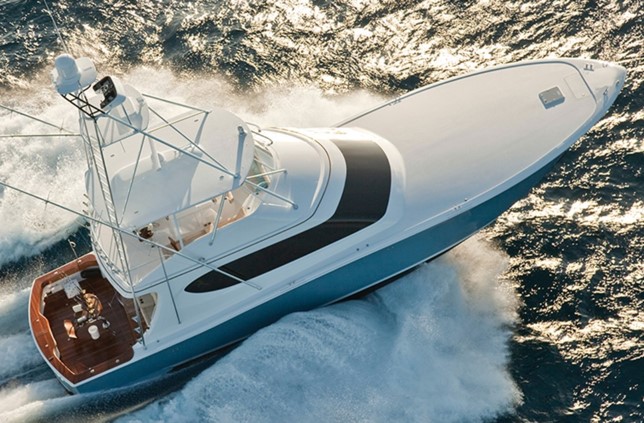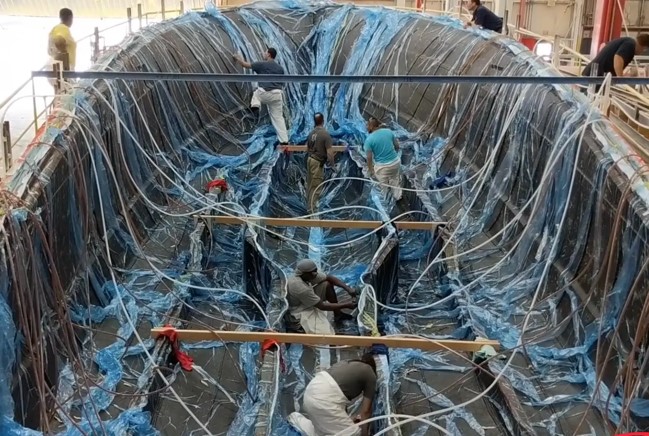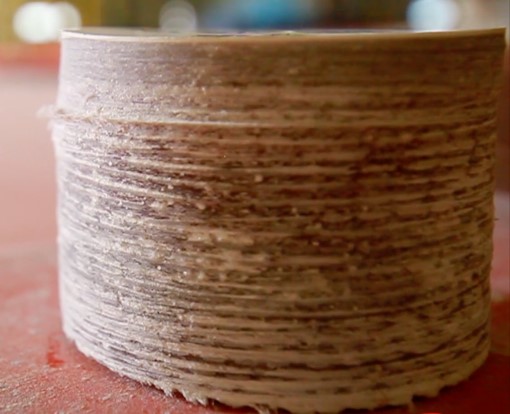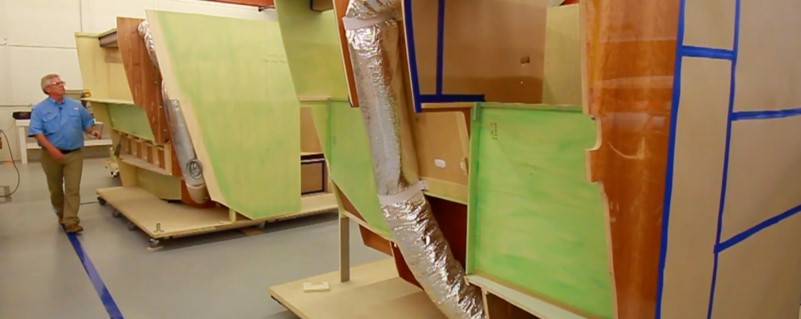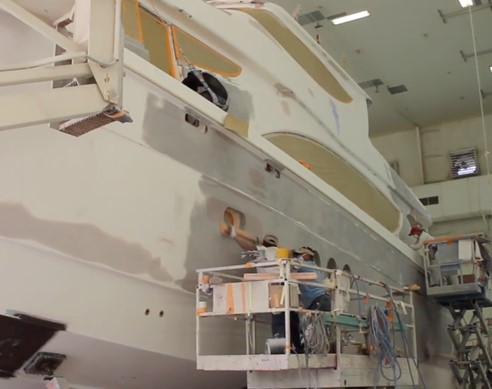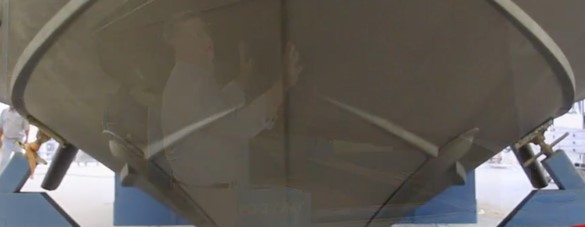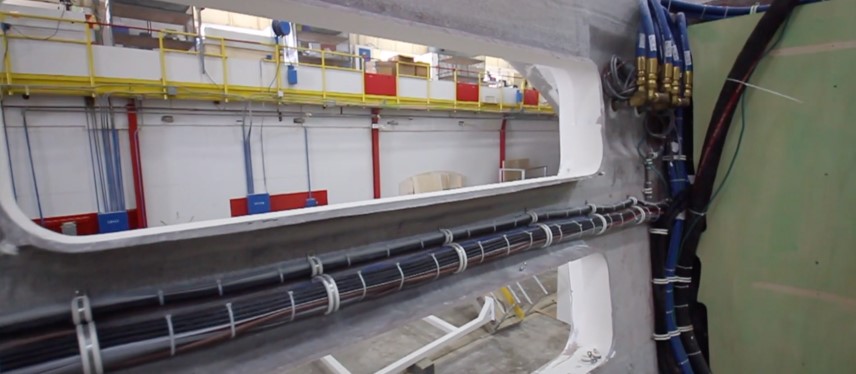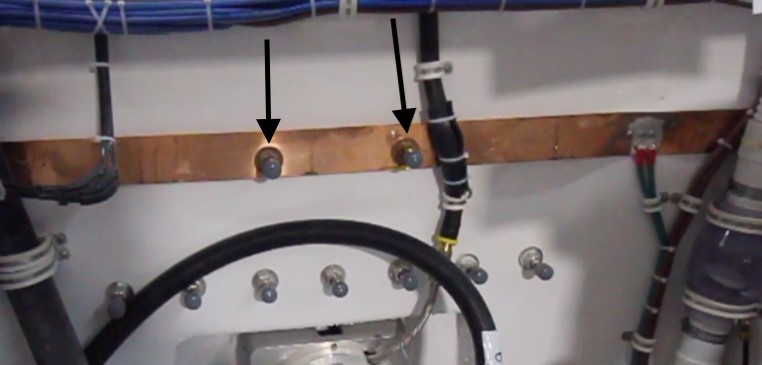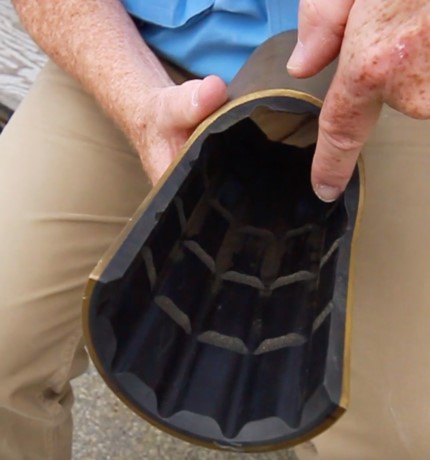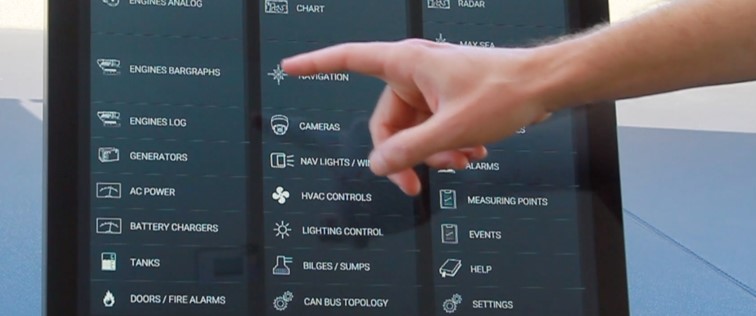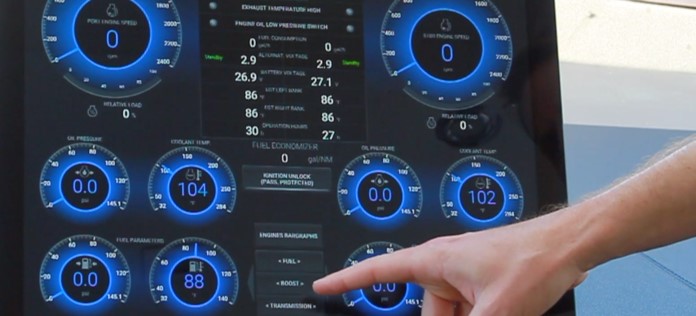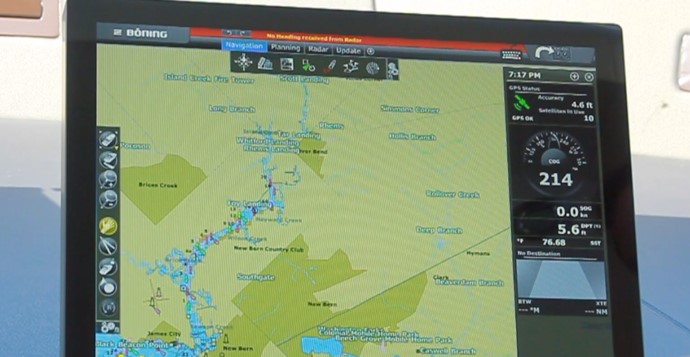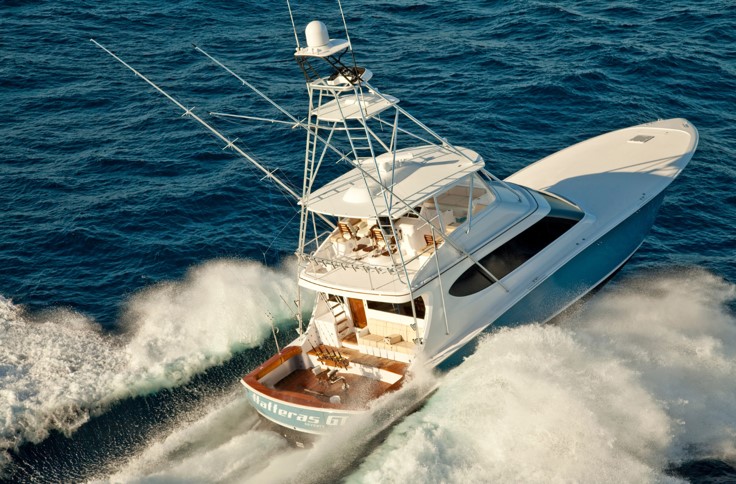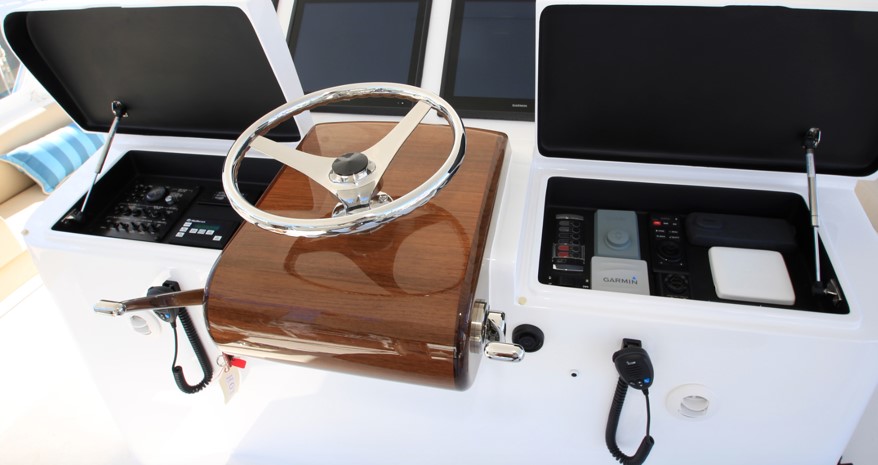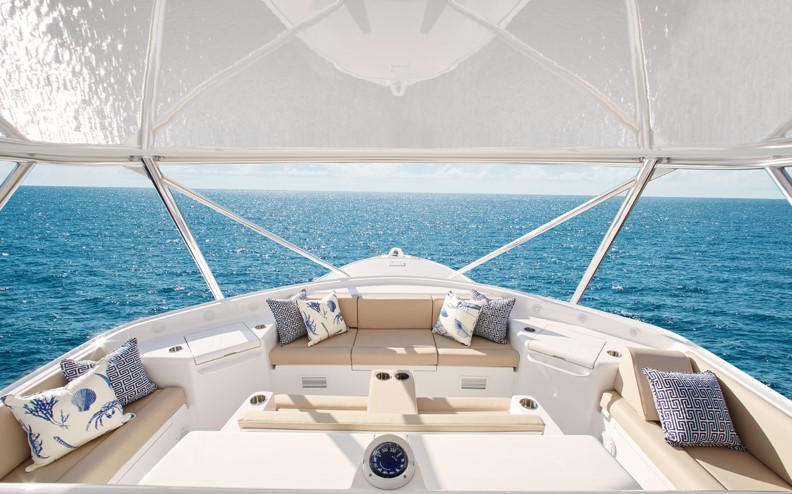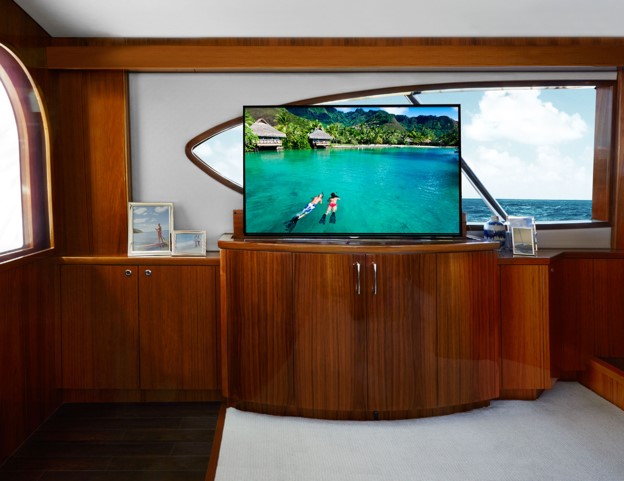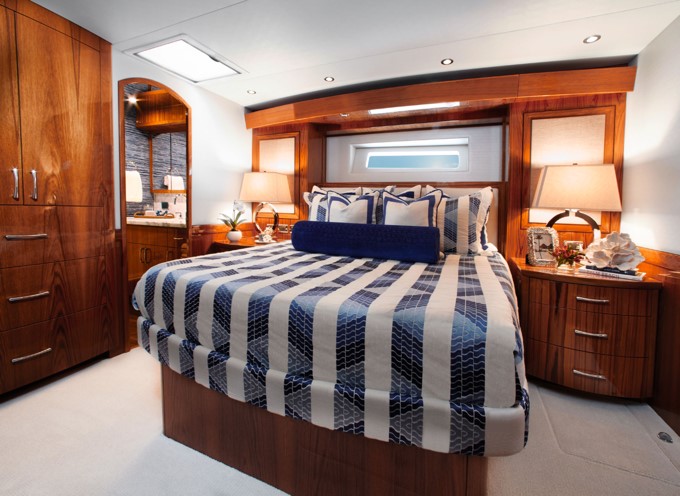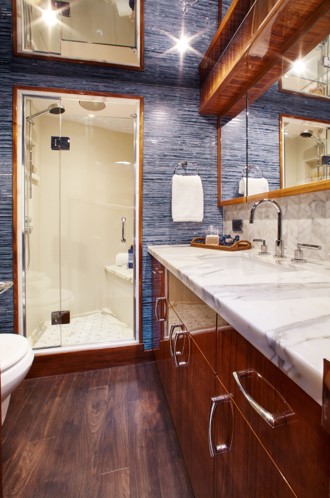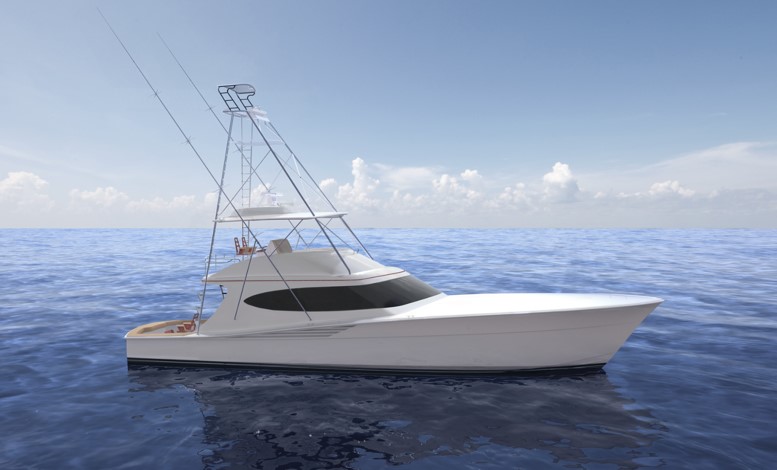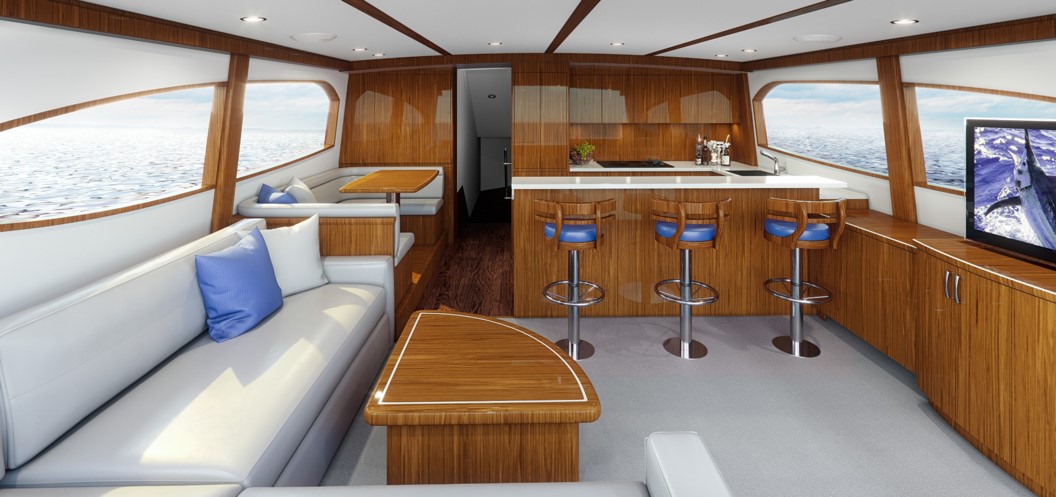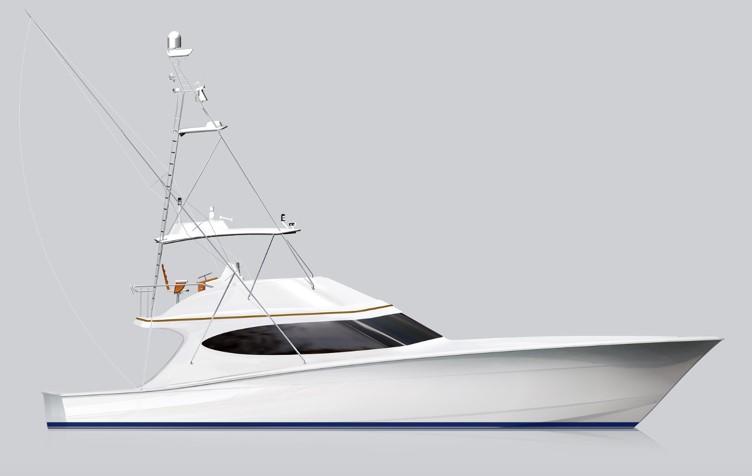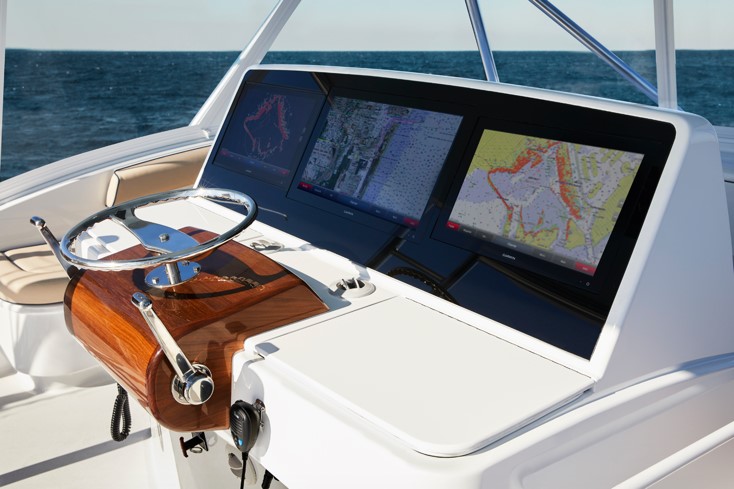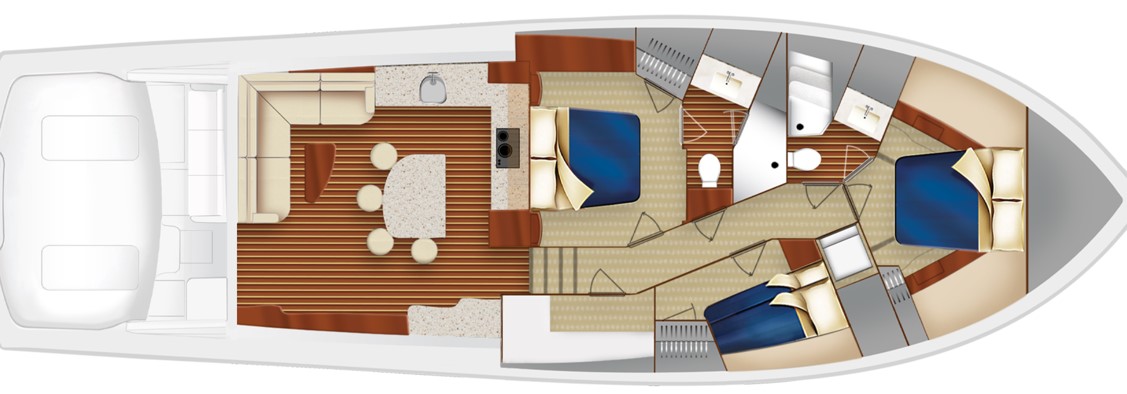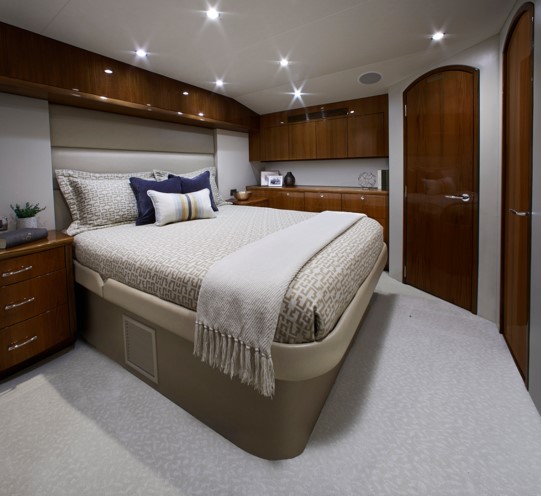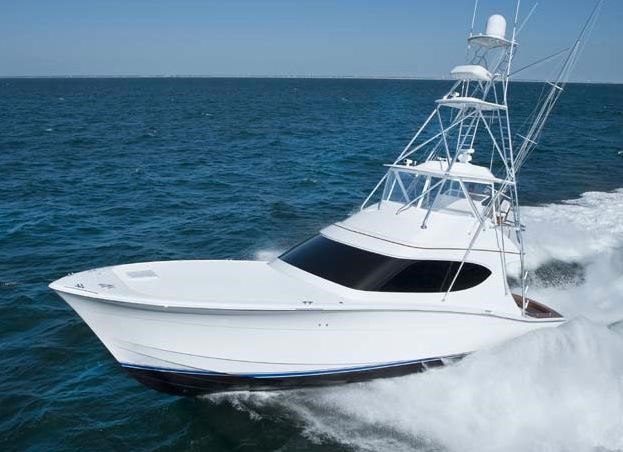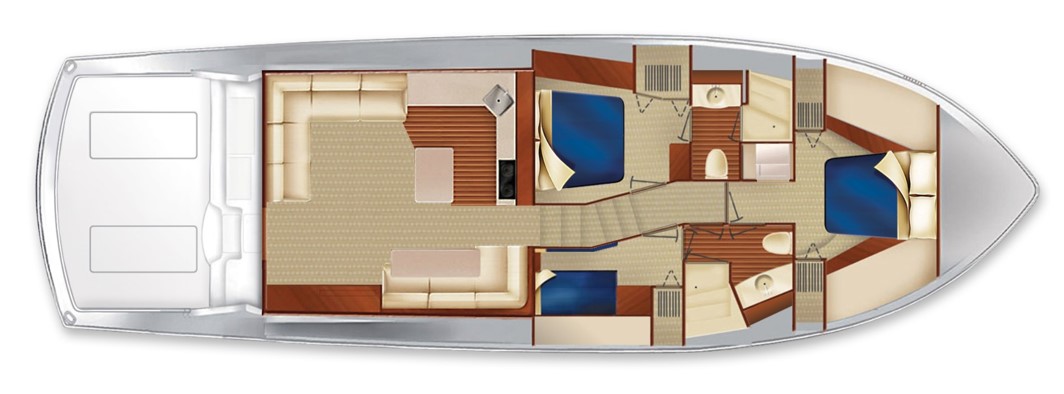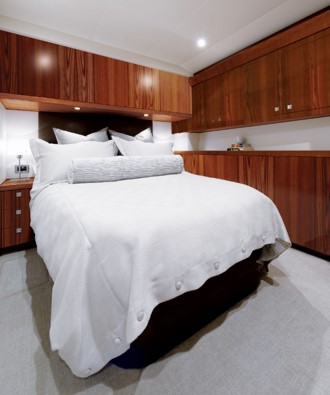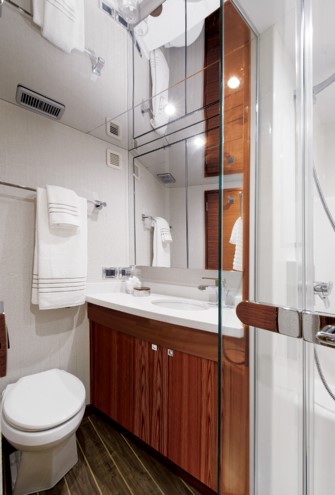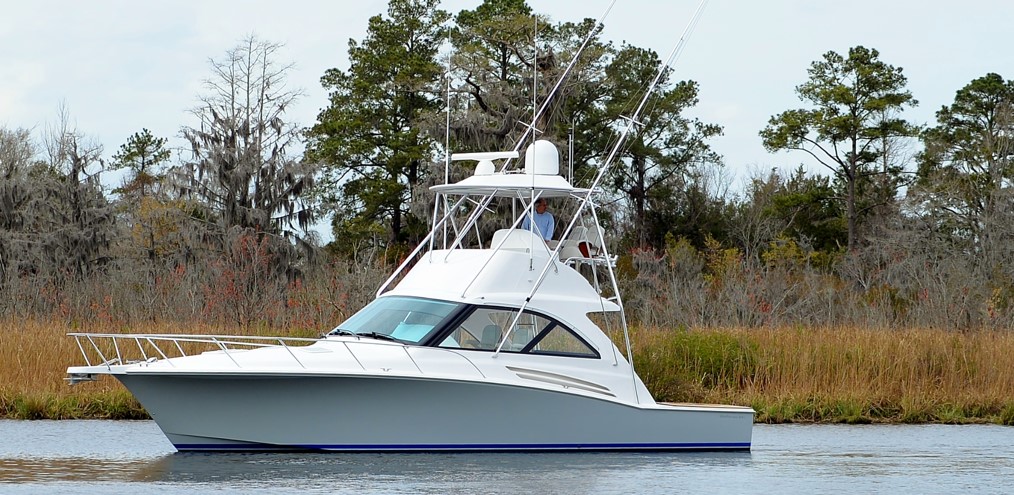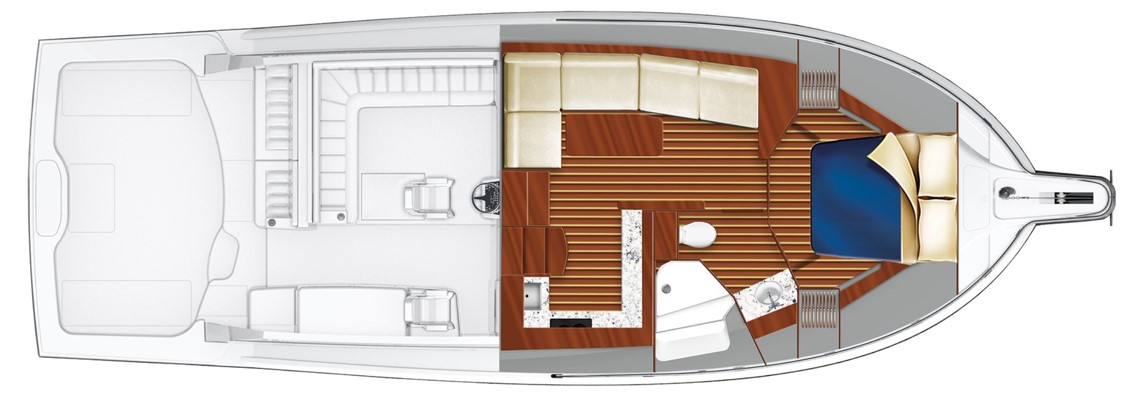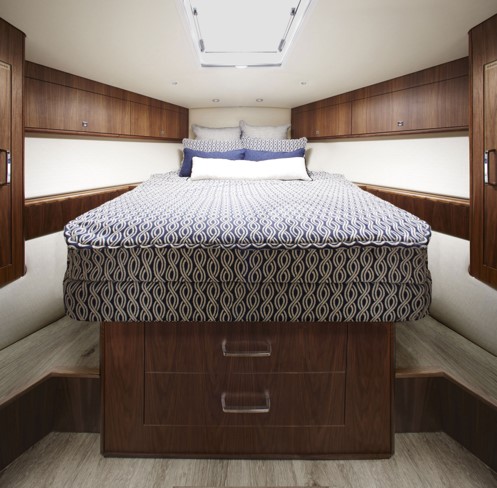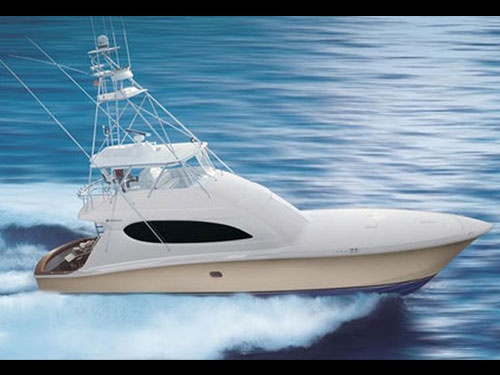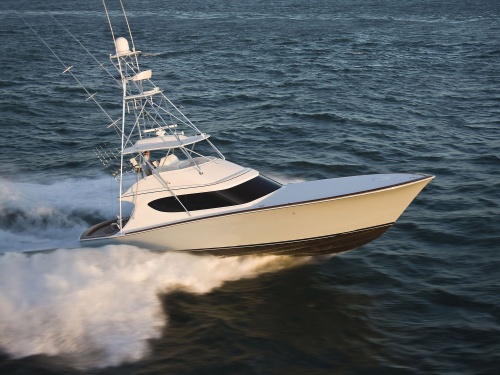Access More Boat Tests
Already have an account? Login
Hatteras The Ultimate Battlewagons
Brief Summary
From design to construction to accommodations, Hatteras builds the premier offshore fishing convertibles.
Editor’s Report by Capt. Martin Frobisher
The term “battle wagon” conjures images of boats crashing through offshore waves in search of giant tuna or marlin. Over time, these vessels have become more refined, combining the best seakeeping traits that a captain wants with the comfort and features that keep the passengers happy during a long run in the ocean.
Arguably the best example of the modern offshore battle wagon is Hatteras Yachts’ series of five convertibles. They range in length from 45' to 70' (13.72 m to 21.34 m) and feature at least two stations from which the captain operates, a large cockpit and dedicated tackle storage for serious angling. The indoor luxurious salons, fully equipped galleys, and belowdeck accommodations rival those found on high-end offshore motoryachts.
Hatteras’ GT Series share many features including convex, modified-V hull bottoms that have variable deadrise angles, side “step outs” and the Carolina Flare that helps give the boats their signature look. Propellers that are custom designed for each boat spin in deep tunnels for maximum performance and efficiency. The tunnels also let the boats draw less than competitive boats.
Hatteras rigs its boats with transmissions that have deep gear ratios. The idea is to improve efficiency and increase thrust when backing down on a fish or into a slip.
Construction
One of many areas where Hatteras separates itself from the competition is in the construction of its convertibles. They all have a solid fiberglass bottom that gives the boats a super-stout feel when underway and makes the boats more impervious to being damaged when they strike a submerged object, such as a rock or cargo container. Conversely, a cored hull is more vulnerable to punctures and requires more experience with composites to repair them if they are compromised.
On the new GT59 and GT65 Carolina, Hatteras updated the construction process for the stringers and bulkheads by using resin-infusion just as it does on the hulls and decks. The bulkheads, stringers, and supplemental supports are all built outside the boat and then glassed in place and then infused to create a single, unified part. The hull and all supporting structures essentially become one piece. The hull, deck and stringers, and bulkheads all have a fiberglass-to-resin ratio of 60:40. Above the waterline, the hull is cored with Divinycell closed-cell foam, as is the deck. Rigging tubes are fiberglassed in place so wires and hoses can be routed through them without the risk of chafing.
The boats’ interiors are built in modules that are installed in the boat as a single piece. To save weight, Hatteras uses what’s known as light marine plywood that weighs about 10 percent less than conventional marine ply. Throughout the boats, the joinery work ranks with the elite in the yachting world.
Paint
The shimmering hulls on all Hatteras products comes from the attention paid to the details in painting its boats. While most manufacturers use gelcoat, Hatteras paints its battle wagons, using a rigorous process that takes a crew of as many as 20 people up to 15 days and involves 10 steps and six different materials.
First, when the hull is removed from the mold, it is de-waxed, sanded, and stripped. Then epoxy is applied to the entire hull and deck and it is then sanded with a longboard in an X pattern. A second coating is applied and the process is repeated. Around hawse holes and window openings, a faster-drying epoxy is used and every inch of the boat is sanded by hand.
When the prep work is completed, the boat is finished with primer, the hull and bottom are painted in the color of the owner’s choosing. The bottom gets similar attention except that after it’s de-waxed, it gets a coat of urethane, then primer and then paint.
Hatteras says the benefits of paint are that it provides owners with a glass-like surface, the epoxy adds durability and that it eliminates the possibility of osmotic blisters that can come with gelcoat. Additionally, paint doesn’t oxidize like gelcoat and to keep paint looking good all it takes is some soap and water.
Rigging
Before the deck goes on, the engines are installed and much of the rigging of the boats is completed. In many cases, Hatteras exceeds American Boat & Yacht Council recommended standards. For example, ABYC calls for two zip ties or tiewraps to be used for additional support for wires, cables and hoses between the stainless-steel cushioned clamps. Hatteras uses three zip ties between the clamps. Additionally, the electrical system is fully bonded with the required green grounding wires and 2” wide copper bonding straps run throughout the bilges of all Hatteras boats.
In the engine compartment, the North Carolina-based manufacturer provides access all around the motors and as much headroom as possible. Routinely checked items, including the fuel-water separators and batteries are positioned with access in mind.
For improved durability, Hatteras has learned from experience and developed some exclusive equipment for its boats. The propeller shafts have round keyways instead of squared ones to better the spread the load on the shaft and reduce stress points. Since making the change, the company has eliminated propshaft failures. The shaft bearing has also been improved. In addition to the longitudinal channels cut into the bearing to let water through, Hatteras adds lateral ones that increase the water flow, improving lubrication.
Rudder shafts are also slotted so the rudder slides into position on the shaft and then it’s welded in place. The slot, not the weld, keeps the rudder from spinning instead, which improves durability.
For the fuel fills, Hatteras developed patented vents so a captain can hang a bucket on them to catch splashback, but thanks to the company’s level indicator between the fuel fills, it’s doubtful there will ever be any fuel splashing back. It lets the captain know when the tanks are at 95 percent so he can start slowing the flow of the fuel. The indicator can also be seen on the Hatt/CON app that the captain and crew can have on their cell phones.
Hatt/CON
To give a captain total command of his vessel, Hatteras introduced Hatt/CON, a proprietary program that controls and monitors every system from screens located throughout the boat. It can also be downloaded to a smart phone, a computer or a tablet. From the home page, a user can hit a category tab for engines, lighting, doors, bilge pumps, circuit breakers, navigation, and more.
Each screen is linked to its own controlling computer and a Master Off lets the user turn of all the lights on board with one switch. Additionally, a person entering a cabin or other area of the boat can still turn on the lights with conventional wall-mounted switches.
For maintenance, as long as the captain/owner of the boat gives Hatteras the password to the boat’s Hatt/CON system, the manufacturer can access it when there’s an alert. The company can diagnose the problem and send out a technician with the equipment and replacement parts needed to make a repair.
The Boats
The GT70
Now let’s take a look at Hatteras’ battlewagon fleet starting with the flagship, the GT70. She measures 73’8” (22.45 m), including her bow pulpit and has a 21’4” (6.5 m) beam and a draft of 5’ (1.53 m) even. Fuel capacity is 2,140 gallons (8,101 L) and the freshwater tank holds 330 gallons (1,249 L).
Powered by twin 1800-hp CAT C-32A diesels, she weighs 120,000 lbs. (54,431 kg). With optional twin 2600-hp MTU engines, we tested a GT70 in 2016, recording a top speed of 41 knots and a cruise of 21.1 knots at 1500 rpm where we saw 0.3 mpg and a range of 632.6 nautical miles with 10 percent of the fuel capacity held in reserve.
On the GT70’s fly bridge, there’s plenty of lounge space for guests to join the captain who is centrally positioned with clear 360-degree visibility, including to the stern so he can see aft when backing down on a fish. There’s also a galley with a large countertop and a table.
Below, the large cockpit has plenty of space for fishing and in the salon, passengers are immersed in luxury. There’s a wraparound lounge to starboard with a cabinet to port that holds a large TV. Forward to port is a fully stocked galley with an island bar with two stools. To starboard is another lounge that wraps around a table.
Belowdecks, the GT70 has a master stateroom with a large berth that faces across the cabin plus a walk-in closet. Forward in the bow are VIP quarters with two smaller closets. Both of these staterooms have ensuite heads with separate showers. Two more cabins have pairs of single berths. One has its own head and the other shares the day head with the occupant of the single crew berth.
The GT65 Carolina
One of the newest boats in the Hatteras fleet is the GT65 Carolina, which measures 68’2” (20.77 m) with her bow pulpit and has a 20’ (6.10 m) beam with a 5’ (1.53 m) draft. Fuel capacity is 1,900 gallons (7,192 L) and she carries 270 gallons (1,022 L) of freshwater. Weight is estimated at 103,000 lbs. (46,720 kg) with twin 1600-hp Cat C-32A diesel engines.
Hatteras designed the GT65 Carolina with a new hull bottom and prop tunnels using computational fluid dynamics. Additionally, the hull and stringer system are infused in a single part. The engine room is designed for an optional Seakeeper 9 gyroscopic stabilizer.
The GT65 Carolina replaces the GT63, which was among Hatteras’ most popular convertibles. The model’s profile refreshes the look of the GT Series and a new flybridge arrangement features an ergonomically designed console that puts all the controls within easy reach. It also incorporates modern fish-finding electronics in a non-glare, flush-mounted, glass cockpit helm array.
The new boat’s cockpit has 194 sq. ft. (18 sq. m) of space and mezzanine seating has built-in stainless-steel storage boxes and the lounge can be equipped with optional integrated seatback air conditioning.
The salon has an aft lounge that wraps around a table to port and the forward galley and dinette are on the same level, giving the GT65 Carolina a spacious feel indoors. Belowdecks, the four-stateroom, three-head layout features a master cabin aft to starboard with a walk-in closet. Forward, VIPs sleep on the same size berth as in the master and both cabins have ensuite heads. To port, there are two cabins with two single berths. One has ensuite access to the day head.
The GT59
Hatteras designed the GT59 for tournament angling life in mind. The sleek convertible combines 40-plus knot top-end speed and outstanding seakeeping ability.
The GT59 has a LOA of 59’9” (18.21 m), a beam of 18’9” (5.72 m), and a draft of 4’9” (1.45 m). She has an empty weight of 89,000 lbs. (40,370 kg). With the 1,750-gallon (6,624 L) fuel tanks and 200-gallon (757 L) water reservoirs full, plus four people onboard, we ran a GT59 at an estimated weight of 101,890 lbs. (46,217 kg).
We tested a GT59 powered by twin Caterpillar C-32A 1900-hp diesel engines, reaching a top speed of 40 knots at 2250 rpm in calm conditions. When we backed off to 2000 rpm and 33.9 knots, we found our best fuel economy with a burn rate of 164 gph and a range of 325.3 nautical miles.
As with the GT65 Carolina, the GT59 has the salon and galley on the same level. There’s an L-shaped lounge aft to port. The galley is forward on the same side and there’s an island bar with three fixed stools.
A passageway to starboard leads belowdecks to the accommodations. The master stateroom is aft to port with a walk-in closet and an ensuite head. Forward, the VIP has its own large berth and a hanging locker plus private entry to the day head. A guest cabin is to starboard and has two single berths arranged bunk style. Hatteras offers scissor-style berths in the bow and a third head is available as well.
The GT54
Equally tournament-capable, the GT54 measures 57’2” (17.43 m) with a 17’3 (5.26 m) beam and a 4’2” (1.28 m) draft. Fuel capacity is 1,200 gallons (4,542 L) and freshwater tankage is listed at 180 gallons (681 L). With twin 1135-hp Cat C-18A diesels, weight is listed at 75,000 lbs. (34,019 kg). Hatteras says she’s capable of speeds exceeding 40 knots at top end with a cruise in the 30s.
The helm station has two captains’ chairs abaft the console with a lounge to starboard and another L-shaped one forward that wraps around to port. The bridge is accessed from a ladder to starboard in the cockpit and the entry closes with a gate.
From her spacious cockpit, it’s a smooth entry to the salon via a starboard door. A large lounge wraps around to port where it meets the forward galley. An island serving bar is centrally located with a dinette table and lounge to starboard.
Belowdecks, the master stateroom is aft to starboard with a large hanging locker and an ensuite head. Forward, the bow cabin welcomes VIPs and has private access to the head, which is also intended for day use. An optional layout has dual scissor-style berths in the bow that can be separated or linked depending on who is sleeping in them. Aft to starboard is a third cabin with two single berths.
The GT45X
The smallest boat in the Hatteras convertible lineup, the GT45X is 47’7” (14.5 m) long with the bow pulpit. She has a 16’6” (5.03 m) beam and a 4’ (1.22 m) draft. Fuel capacity is 800 gallons (3,028 L) and water is 100 gallons (379 L). With twin 835-hp Cat C-12.9 engines, she weighs an estimated 49,700 lbs. (22,543 kg).
Engine upgrades are available and Hatteras estimates the top speed at 40.8 knots and a cruise of 36 knots with twin 1,136-hp Cat C18s.
Her bridge has two captains’ chairs at the helm with lounges to starboard and on the forward side of the console. The captain has good all-around visibility, including to the stern with the controls positioned comfortably for the captain to turn around while backing down on a fish or pulling into a slip.
The cockpit has ample space for fishing with aft-facing lounges forward. Step up to the lower helm deck where there are three captains’ chairs and a centrally positioned helm. The captain has excellent all-around visibility.
Belowdecks, the GT45X can have one or two staterooms. The former has the cabin in the bow with private access to the head to starboard. Aft to starboard is the galley with an L-shaped lounge and table to port. The optional second cabin would be to port with over-under bunks and creates a shorter lounge for the dinette.
Conclusion
The first Hatteras convertible was built to handle rough seas and unpredictable, windy conditions found off its namesake North Carolina cape. That heritage is still alive in the Hatteras GT Series of convertibles. They combine the legendary manufacturer’s seakeeping abilities with the luxury that discerning anglers are looking for.

